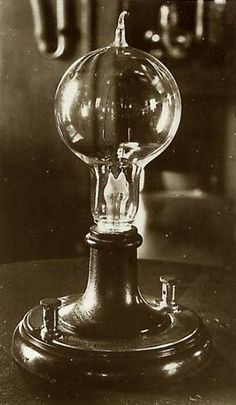
Keeping Away the Darkness: The Electrification of Cities
This week marks the anniversary of an very momentous event in modern civilization: Dec. 31 is the day Thomas Edison first demonstrated his incandescent lightbulb in Menlo Park, NJ.
The lightbulb was nothing new in 1879. It had been around longer than the 32-year-old Edison. Older models were expensive and didn’t burn for long. Edison and his research team merely perfected the lightbulb, making modern electrification of cities possible.
On that fateful winter night in 1879, Edison’s workshop and the street were illuminated. Scores of people showed up to watch between 50 and 60 lights, the Camden, NJ, Courier-Post reported.
Edison “should keep increasing this number daily, as rapidly as was practical, and in five weeks he hoped that he would have 800 lights burning,” the paper said Jan. 1, 1880. “He should increase the number of the lights as fast as he could increase his facilities for generating the electricity.”
Race to Illuminate Cities
It didn’t take long for municipalities to see the benefits of electric lighting.
In fact, some cities already had begun to make the switch. Cleveland, for example, began lighting its streets in spring 1879 using a system, the arc lamp, developed by inventor Charles Brush.
Each lamp produced as much light as 4,000 candles.
“Positioning 12 arc lamps around the square, the demonstration attracted thousands of onlookers,” Cleveland Magazine says. “Not knowing what to expect, they wore smoked glasses to protect their eyes. Then, at 7:55 p.m. on April 29, 1879, the first flicker took, the system powered up and Public Square became the first outdoor public space in America fully illuminated by electrical light. The Cleveland Grays Band played from a pavilion on the square with a gun salute over the lake.”
Ten years later. Brush sold his company to a business that soon would merge with fellow Ohioan Thomas Edison’s General Electric.
More than 130,000 arc lights were installed in the United States by 1890. Eventually, these bulbs would be replaced with incandescent versions.
The White City
For many, however, the first time they saw illuminated streets was during the 1893 Chicago World’s Fair, nicknamed the White City.
Fairgoers were unaware of the history of the fairground’s development. The White City was illuminated by incandescent bulbs, but they weren’t powered by Edison’s electric delivery system. His direct current system has lost out to Nicola Tesla’s alternating current.
Tesla won the contract, and his system powered hundreds of bulbs for the duration of the fair.
This video shows footage of the fair at night:
Where to Purchase the WWI Trilogy
This post is a companion piece to Melina Druga’s WWI Trilogy: Angel of Mercy, Those Left Behind and Adjustment Year. The trilogy focuses on Hettie and her family as they navigate the challenges and heartbreak World War I brings.
Angel of Mercy: A nurse reluctantly sacrifices her career for marriage. An impending war will change her, and her husband’s, life forever. Available in eBook, paperback and hardcover. Click here for a full list of retailers.
Those Left Behind: The brewing winds of war will soon rip the family apart. Available in eBook, paperback and hardcover. Click here for a full list of retailers.
Adjustment Year: A war nurse returns home. Society expects her to carry on as if the Great War never happened. But how can she? Available in eBook, paperback and hardcover. Click here for a full list of retailers.
